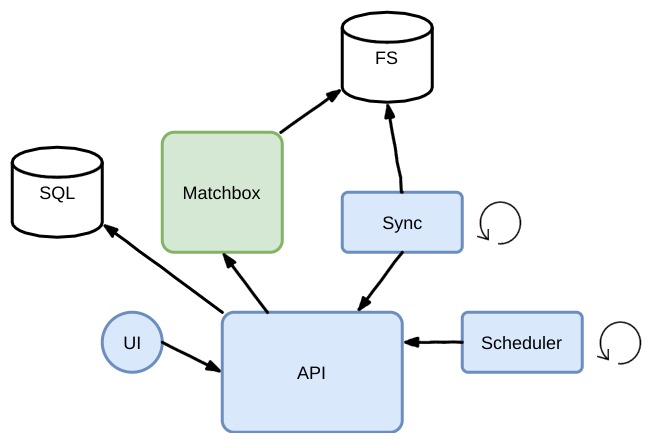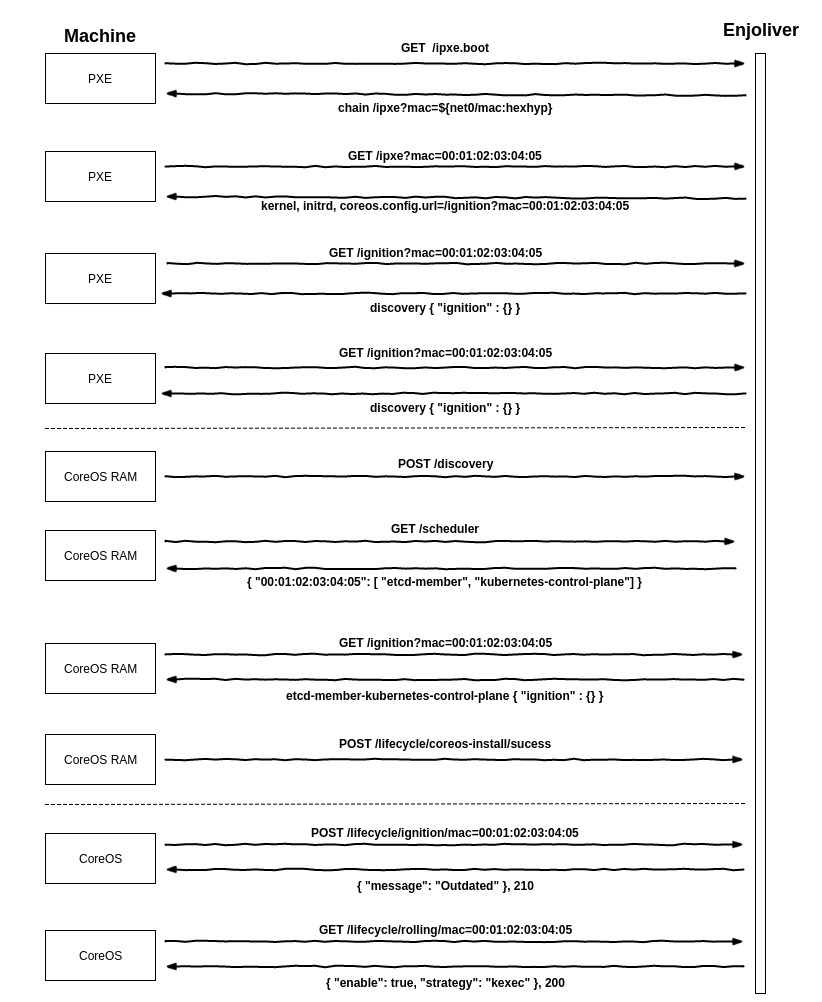JulienBalestra / Enjoliver
Programming Languages
Projects that are alternatives of or similar to Enjoliver
Enjoliver
Travis-ci (com / org)
Description
Deploy and maintain an usable Kubernetes cluster.
The Kubernetes Kubelet container runtime is rkt.
During the lifecycle of the Kubernetes cluster, rolling updates are fast and fully controlled.
- The rolling update of the configuration changes are granted by Enjoliver API
/lifecycle/rolling/mac=00:01:02:03:04:05 - The semaphore is managed by locksmith.
- The Ignition is applied after a fast systemd-kexec or normal reboot
Each node can be re-installed and re-join the cluster.
The project is divided in 4 main topics:
-
Configuration of Kubernetes cluster roles:
- control plane
- node
-
Enjoliver Engine
- Discovery Topology
- Scheduling of Kubernetes roles
- Lifecycle management
-
Enjoliver e2e testing
- follow any associated releases
- features, bug fix testing in cluster
-
Kubernetes cluster for development usage, ready to use with sample:
- Helm / Tiller
- Heapster
- Kubernetes Dashboard
- Kubernetes state metrics
- Node exporter for Prometheus
- Prometheus
- Vault UI
- CronJobs for etcd3 backups
1. Kubernetes Cluster
Kubernetes controller manager is deployed as Pod on each nodes of the control plane. When the control plane runs the controller, the scheduler starts as a DaemonSet.
Vault, Kubernetes and Fleet have dedicated etcd clusters.
Vault pki backend secure the following components:
- etcd for fleet - API v2
- peer
- client
- etcd for kubernetes - API v3
- peer
- client
- kube-apiserver
- x509 authentication for kubectl
- service accounts
- kube-controller-manager
- cluster signing key
- kubelet
Each etcd cluster supports automatic members replacement.
The configuration of each host is managed by Ignition.
Current Stack
Upstream
- etcd
- cni
- rkt
-
kubernetes
- PR: ~/aci/aci-hyperkube/patches
- vault
- Container Linux
Stick
2. Enjoliver Engine
Matchbox
Enjoliver use 3 profiles in matchbox
- discovery
- etcd-member-kubernetes-control-plane
- kubernetes-node
Discovery
The discovery allows to boot in memory CoreOS instances to proceed of:
- sending the facts of the machine (MAC address, IP address, ...)
- fetch his role
- disk installation
For matchbox, the discovery profile has one group without any selector.
In this case, all un-selected machines will match this profile by default. This profile has one associated group, with 2 metadata entries:
- api uri
- ssh-key
How the discovery process works:
etcd-member-kubernetes-control-plane
This role is for:
- etcd members
- vault
- fleet
- kubernetes
- vault
- kube-{apiserver, controller-manager, scheduler}
This role need to be bootstrapped as 3, 5, ... instances and is needed by all the other nodes.
To solve this problem, the Enjoliver Scheduler will apply the roles only if the required number of instances are available.
So, if the cluster size is 5, the first 5 instances in discovery will get this role.
kubernetes-node
This role is a standard worker (Kubernetes node)
All additional nodes over the wanted etcd-member-kubernetes-control-plane requirements will become kubernetes-node
Rolling Update
Each minute, every machine reports the content of /usr/share/oem/coreos-install.json to the enjoliver API lifecycle/ignition/
Enjoliver will query matchbox and compare the content of the current ignition report and the desired ignition provided by matchbox.
The result will be stored in the database and returned to the machine.
If the state is outdated, the machine will ask its rollingUpdate strategy:
- disable : unset
- kexec
- reboot
- poweroff
If a strategy is returned, the machine try to takes a lock in locksmith and proceed to tear down the machine. The tear down proceed to drain the kubernetes node. Its disable the scheduling of the node.
When the machine goes back, the ready process starts:
- check etcd-vault
- check etcd-kubernetes
- check etcd-fleet
- check kubernetes cluster trough the local kube-apiserver
- check the kubelet
- check if the node is registered in fleet machines
- trough local etcd-fleet
- over remotes etcd-fleet
- uncordon the kubernetes node
- release the lock in locksmith
Enjoliver API
Everything has to go through this endpoint.
This is the available routes:
[
"/",
"/apidocs/",
"/apidocs/index.html",
"/apispec_1.json",
"/assets",
"/assets/<path:path>",
"/backup/db",
"/backup/export",
"/boot.ipxe",
"/boot.ipxe.0",
"/config",
"/configs",
"/discovery",
"/discovery/ignition-journal",
"/discovery/ignition-journal/<string:uuid>",
"/discovery/ignition-journal/<string:uuid>/<string:boot_id>",
"/discovery/interfaces",
"/flasgger_static/<path:filename>",
"/healthz",
"/ignition",
"/ignition-pxe",
"/ignition/version",
"/ignition/version/<string:filename>",
"/install-authorization/<string:request_raw_query>",
"/ipxe",
"/lifecycle/coreos-install",
"/lifecycle/coreos-install/<string:status>/<string:request_raw_query>",
"/lifecycle/ignition",
"/lifecycle/ignition/<string:request_raw_query>",
"/lifecycle/rolling",
"/lifecycle/rolling/<string:request_raw_query>",
"/metadata",
"/metrics",
"/scheduler",
"/scheduler/<string:role>",
"/scheduler/available",
"/scheduler/ip-list/<string:role>",
"/shutdown",
"/static/<path:filename>",
"/sync-notify",
"/ui",
"/ui/view/machine",
"/ui/view/states"
]
A Swagger UI is available at /apidocs/index.html
The Enjoliver API is backed by a SQL database.
Sync
Matchbox store his state inside filesystem folders (JSON).
To keep it up-to-date, the sync process query the Enjoliver API /scheduler/...
In this current topology, the matchbox state isn't critical and can be regenerated at any time.
Scheduler
By querying the Enjoliver API /scheduler/available, the scheduler can affect discovery instances to a role.
Production - Baremetal
You can take as example the aci/aci-enjoliver to see how the rkt container is built with dgr
Fulfill the configuration file app/configs.yaml
About the aci, you need pass all the dgr test or adapt the ignition files.
Development - Local KVM
This part will soon have a better documentation.
If you still want to try you can follow this steps:
Requirements:
-
Linux with filesystem overlay for
dgr - See
apt.shfor the needed packages orsudo make apt - See
.travis.ymlas a setup example & unit / integration tests
All in one dev setup:
# Clone the project inside a valid GOPATH
git clone https://github.com/JulienBalestra/enjoliver.git ${GOPATH}/src/github.com/JulienBalestra/enjoliver
# Be sure the GOPATH is fowarded across Makefiles or do it step by step
sudo -E make dev_setup
Step-by-step:
make submodules
make -C runtime dev_setup
make -C app/tests testing.id_rsa
make front
make pip
make -C matchbox/assets/discoveryC
make -C matchbox/assets/enjoliver-agent
# Very long:
sudo -E make aci
sudo -E make container_linux
# misc
make config
sudo -E chown -R ${SUDO_USER}: $(CWD)
# Validate
make validate
Start an interactive Kubernetes deployment of 2 nodes:
# Start the deployment
sudo make -C app/tests check_euid_it_plans_enjolivage_disk_2_nodes
The enjoliver API is available on 127.0.0.1:5000, the user interface is behind the /ui
At the end of the setup, a kubectl proxy is running on 127.0.0.1:8001
Starting to serve on 127.0.0.1:8001
#####################################
mkdir -pv ~/.kube
cat << EOF >> ~/.kube/config
apiVersion: v1
clusters:
- cluster:
server: http://127.0.0.1:8001
name: enjoliver
contexts:
- context:
cluster: enjoliver
namespace: default
user:
name: e
current-context: e
kind: Config
preferences:
colors: true
EOF
kubectl config use-context e
#####################################
Connect inside with ssh:
./app/s.sh





